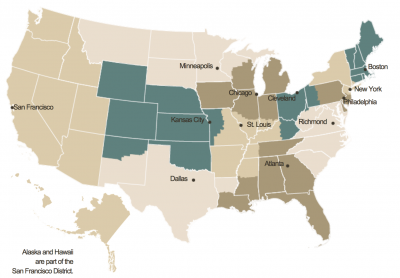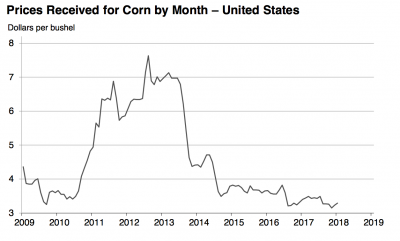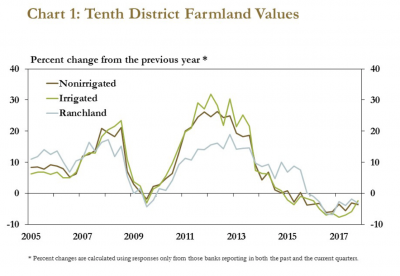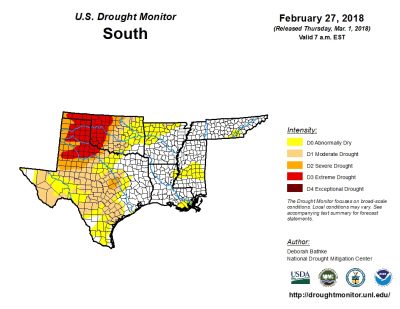Beef prices are projected to continue increasing as U.S. beef production declines with no signs of a cattle herd rebuild. Additionally, cheap beef may soon become further out of reach…
Federal Reserve: Observations on the Ag Economy- February ’18
On Wednesday, the Federal Reserve Board released its February 2018 Beige Book update, a summary of commentary on current economic conditions by Federal Reserve District. The report included several observations pertaining to the U.S. agricultural economy.

* Sixth District- Atlanta– “Agriculture conditions across the District were mixed. Drought conditions persisted in much of the District. However, rain in February brought some relief. The January forecast for Florida’s orange crops was down further from the previous report as the effects of the Hurricane Irma continued to be felt. On a year-over-year basis, prices paid to farmers in December were up for cotton rice, beef, broilers, and eggs and down for corn and soybeans.”
* Seventh District- Chicago– “Expectations for overall farm income in 2018 improved somewhat in January and early February, though much of the District’s farm sector remained under stress. There were reports of more small tracts of ground being offered for sale.
Corn and soybean prices were up enough to cover a slight rise in projected production costs for 2018.


“Soybeans remained more profitable than corn for most operations—one contact predicted that the split of corn and soybean acres planted this spring will be close to even (corn has consistently comprised the larger share).”

“Contacts noted that subsoil moisture was very depleted in many areas because of drought conditions last year, making timely spring and summer rains more important for crop health this coming growing season. Hog, cattle, and egg prices were higher, but dairy prices lagged, leading to an increase in the number of liquidations of diary operations.”
* Eighth District- St. Louis– “District agriculture conditions have improved slightly since the previous reporting period. In spite of concerns about low temperatures in early January, the percent of District winter wheat rated fair or better ticked up about a percentage point from the end of December to the end of January.
Contacts expressed optimism about near-term farm income as area farmers were able to turn strong yields into profits in 2017, although some expressed concern about the downside risks of NAFTA renegotiations.
* Ninth District- Minneapolis– “District agricultural conditions were stable at low levels. Respondents to the Minneapolis Fed’s fourth quarter (January) survey of agricultural credit conditions indicated that farm income and capital spending decreased relative to a year earlier, with further declines expected for the coming three months. Most of the Dakotas and portions of Montana were experiencing below average snowfall over the winter, with concerns that drought conditions could persist into the spring planting season.”
* Tenth District- Kansas City– “The Tenth District farm economy remained weak, but farm real estate values slowed their decline from the previous months, providing some stability for farm finances.

Farm income continued to decrease.
“Agricultural credit conditions weakened further against year-ago levels, but at a more modest pace than in previous reporting periods. Although prices for most agricultural commodities increased slightly in February, prices for corn, soybeans and hogs were still lower than a year ago. Alongside an increase in cattle, wheat and cotton prices, farmland values declined only slightly and stabilized significantly in the western portion of the District. Conditions in the farm economy in Oklahoma also improved notably due to an increase in cotton acreage and a moderate increase in cotton revenues.”
* Eleventh District- Dallas– “Agricultural producers were concerned about worsening drought conditions. As of February 20, 70 percent of Texas was experiencing at least moderate drought, with some extreme drought in the High Plains and Panhandle.

“However, rainstorms late in the reporting period likely alleviated the dry conditions in parts of the state. The cattle sector remained solid with strong demand for beef, both domestic and international, and rising cattle prices. However, the dairy industry continued to struggle with declining prices.
Cotton acreage will likely be up in Texas this year, and there was excitement among producers about cotton provisions being added back into the Farm Bill legislation.
“Financial concerns continued among grain farmers as they prepared for planting, with crop prices remaining low and some inflation seen in fuel and fertilizer costs. NAFTA renegotiations also remained a source of concern and uncertainty.”
* Twelfth District- San Francisco– “On balance, conditions in the agriculture sector deteriorated modestly. Low snow and rainfall over the reporting period limited new planting in Central California and resulted in weak crop yields. Contacts in Idaho noted that excess supply drove a decline in dairy sector profits to breakeven levels, with smaller producers being hit particularly hard. Grain inventories in the Mountain West were at record levels. Conditions in the swine industry continued to improve on a year-over-year basis. Increased global demand for beef products boosted feed lot utilization.”





